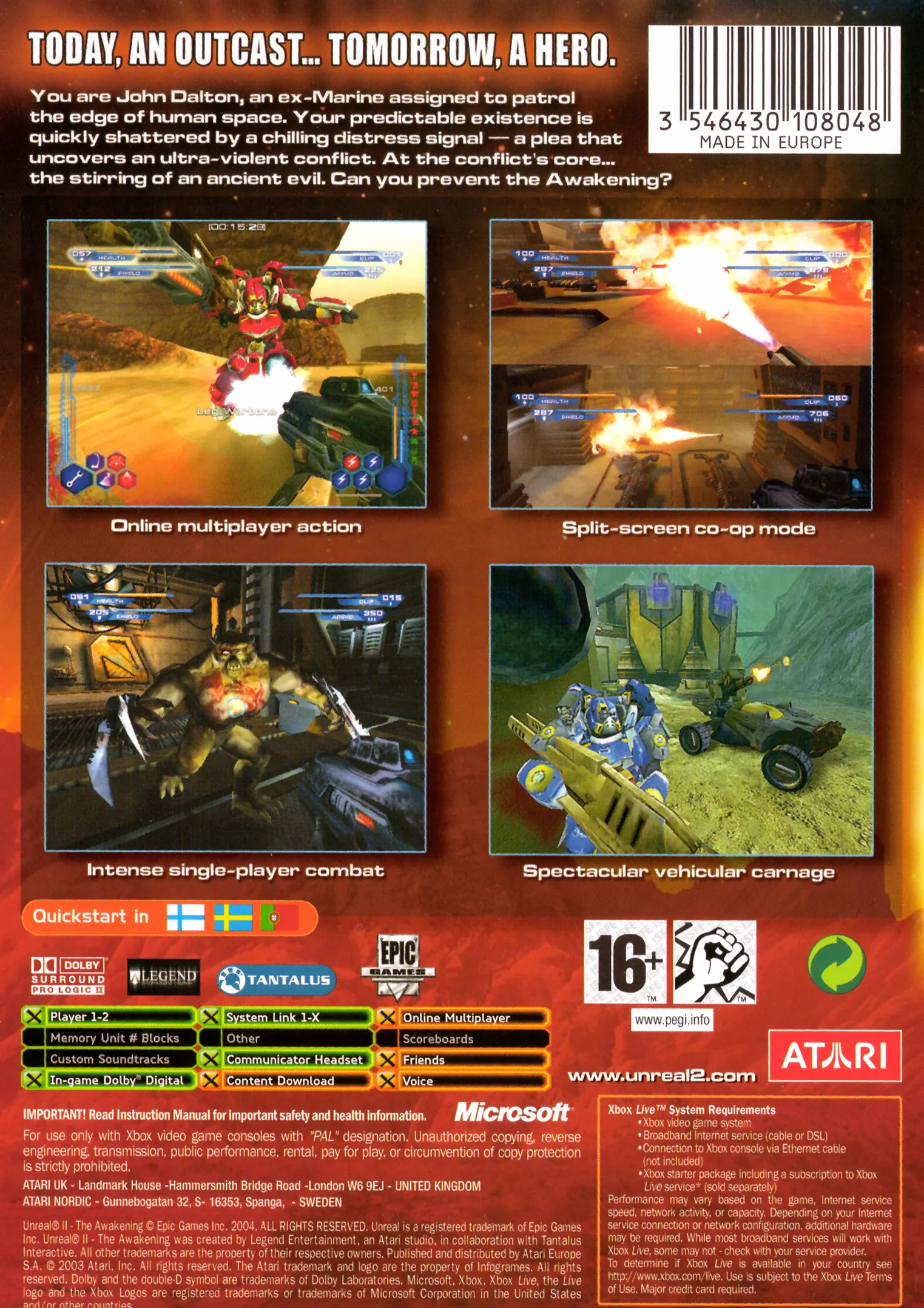home ➜ Original Xbox Game Console ➜ Unreal II: The Awakening
Unreal II: The Awakening - Prevent the awakening of an evil force
Information
Unreal II: The Awakening
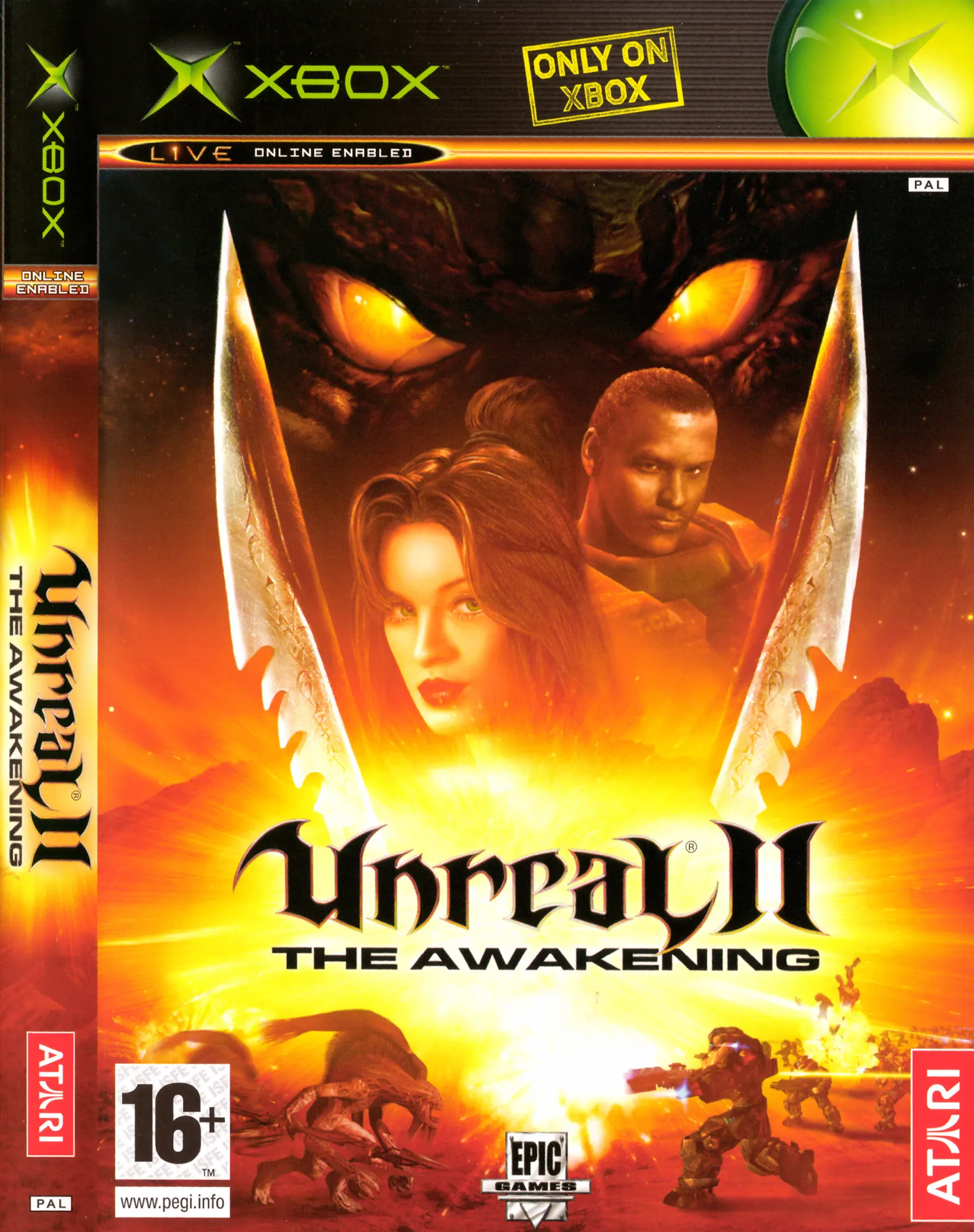
- Developer: Legend Entertainment and Tantalus Interactive
- Publisher: Atari
- Game Rating: M (Mature) [Blood and Gore, Game Experience May Change During Online Play, Violence]
- Release Date: February 10, 2004
- $39.99 / $11.00: Game Stop - Roseville: December 17, 2005
- Players: 1 - 2
- Players via System Link/LAN Cable: 2 - 12
- Play Modes: SinglePlayer, Co-Op and Multi-player Same/Split-Screen
- Players via Online: 2 - 12
- HDTV 480p, Dolby 5.1 Surround, SystemLink , Xbox LIVE Multiplayer
Introduction
The Unreal adventure continues with the release of the action shooter Unreal II: The Awakening. Along the outer edge of space, you are plunged into a desperate mission to kill all comers — alien and otherwise — and prevent the awakening of an evil force. Unreal II: The Awakening includes adrenaline-pumping destruction and impressive visuals in both solo levels and team multiplayer combat. Player-controlled vehicles add to the carnage, acting as both transport and heavy weaponry. Now, through scorching heat, over icy terrain, and within eerie alien cities, are you ready to launch into battle?
As a representative of the law on the edge of human space, in Unreal II — The Awakening you must prevent interstellar war and discover the meaning of the mysterious artifacts.
Supported by your crew, encounter beautiful alien worlds and vicious enemies. It is up to you to achieve peace through superior firepower.
Famed Unreal engine technology. Experience enormously detailed graphics (fire, hair, and clothing) and a wide range of battlegrounds, from the breathtaking vistas of vast alien worlds to claustrophobic underground tunnels.
Description
Some years after the Strider Wars, humanity has resumed its expansion into space. On the rough frontier, it falls to the Terran Colonial Authority to maintain peace and order among the outlying colonies and outposts. TCA Marshal John Dalton and the crew of his ship, the Atlantis, patrol this dangerous sector of space when several distress calls lead to the discovery of alien artifacts with unique properties. Soon, the hunt for these artifacts is on between several alien factions as well as human corporations and their mercenary forces, with the TCA and their allies caught in the middle.
The first-person shooter Unreal II, while a sequel to Unreal, has no direct connection to the first game except being set in the same universe (with the Skaarj from Unreal and the Liandri Corporation from Unreal Tournament being major enemy factions). The player controls John Dalton through a dozen missions, taking place in such locations as the dense jungle of a tropical planet, a research facility on a frozen moon, the insides of a planet-sized living organism, the home world of an insectoid machine civilization, as well as a huge starship.
The weapon arsenal consists of more than a dozen guns. Standard types include pistols, an assault rifle, shotgun, and sniper rifle. Some heavier ones are a flame thrower, as well as rocket and grenade launchers, with the grenade launcher being able to use six different ammunition types, including fragmentation, EMP and smoke grenades. Available in later missions are weapons adapted from alien technologies. These include various energy guns, a biological weapon that creates living spiders that attack enemies, and an autonomous floating orb that either seeks out and attacks enemies or circles around the player in point defense. As in other Unreal titles, each weapon has two different firing modes.
Missions are usually of the run-and-gun type, but there are exceptions. Several levels include defense assignments where either a position must be held for a certain time or a character be kept alive. These levels usually include additional tools such as energy barriers and automated turrets that can be placed by the player in any location. Sometimes, AI-controlled characters will be there to help out the player as well. In that case they can be given orders on which sector to defend or patrol, for example.
The story of the game is told through a variety of means: besides in-engine cutscenes, there is a lot of radio chatter during a mission; in fact, it's not unusual for mission objectives to completely change due to story developments. Between missions, Dalton can wander freely about the Atlantis and chat with his crew, going into their personal backstories as well as more details about the main plot.
Overview
The game is described as a sequel to Unreal, though many of the story elements, including the characters and locations, are entirely unrelated to the original, and you get to progress through the missions as an entirely new character. The presence of the notorious Skaarj in modest numbers is probably the viable reminder of the Unreal universe.
The player controls a former Marine John Dalton, a Terran Colonial Authority Marshal whose job is to patrol remote areas of space, which are far away from any real action. He is called back into service to retrieve seven pieces of an ancient artifact thought to make a powerful weapon when assembled. The plot follows a linear path like many other First Person Shooters, while the character goes to various planets in search of the artifacts. The level design at each location is also linear, with only a certain amount of puzzle solving and key finding.
The environments on each planet are quite diverse, ranging from tropical to desert, bunkers and industrial installations, alien cities and even cavities inside the bodies of aliens. During several missions, the player must hold a location against waves of incoming enemies, in some cases using NPCs as support. Overall it is a short game, comprising only 12 missions.
Development history
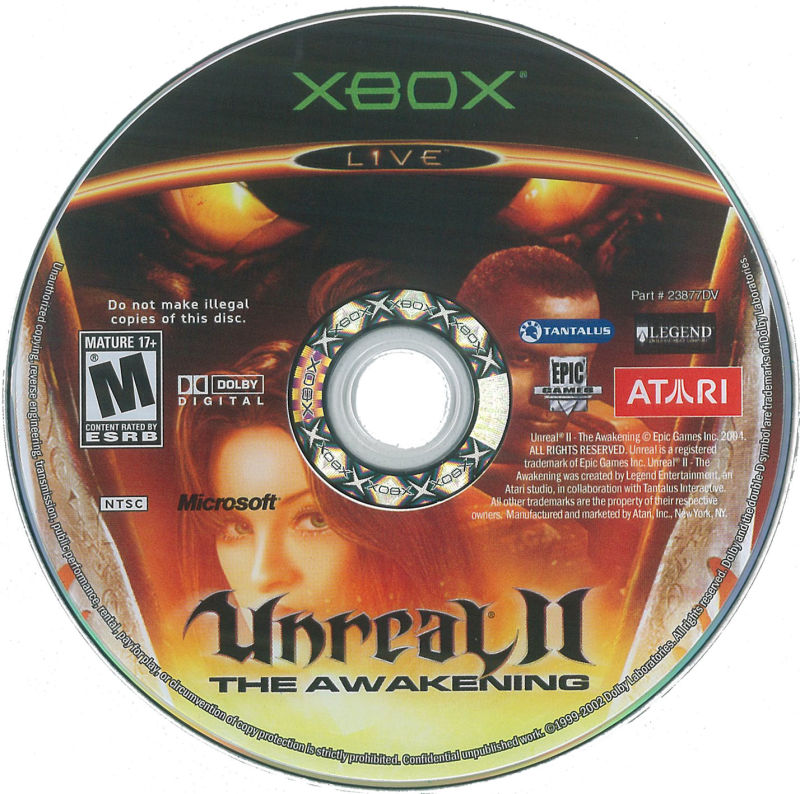 The game was officially, yet quietly, announced back on October 14, 1998 by Epic Games. Primary development on Unreal II was performed by Legend Entertainment, with some assistance by Epic Games, and published by Atari Games. The official site launched in 2001. Mike Verdu was initially the producer of the game, but left Legend near the end of the year in order to join Electronic Arts, and was replaced by Glen Dahlgren.
The game was officially, yet quietly, announced back on October 14, 1998 by Epic Games. Primary development on Unreal II was performed by Legend Entertainment, with some assistance by Epic Games, and published by Atari Games. The official site launched in 2001. Mike Verdu was initially the producer of the game, but left Legend near the end of the year in order to join Electronic Arts, and was replaced by Glen Dahlgren.
Plenty of stuff got cut during the planning stage such as voice over IP and vehicles. VoIP was cut early in the planning stage because it was not a priority, and with multiplayer being dumped, it never had a chance to be implemented. As for vehicles, the dev team believed that they should become part of the gameplay from the beginning, and U2 was not thought with vehicles in mind. Also, while there would be mod support on release, there would not be cross-support with Unreal Tournament 2003, as the differences between both versions of the Unreal Engine 2 prevented a native crossover between the two titles.
The game was originally meant to be a single player-focused game with multiplayer features, and was advertised as more of an adventure game than a casual blaster. Exactly a half of the game was cut from Unreal II. The multiplayer mode got cut in March 2002 in lieu of the then-Unreal Tournament II (later Unreal Tournament 2003). The content that was cut include three races that includes nine or more enemies (N, Striders, Shian), five weapons (Tractor Beam, Stun Baton, Mind Claw, Shock Rifle and Flak Cannon), seven SP maps, around 10 multiplayer maps and several more multiplayer maps, various graphics, gameplay and sound technologies such as MP3 music player, Co-op support, multiplayer support, dynamic conversation system and armor changing.
Before the release of the game, Dahlgren told BU that the game's version of UnrealEd would not be binary-compatible with the version of the editor which came with UT2003, so it is not possible to use the editor to create levels for UT2003 and viceversa. It was also confirmed that Unreal II and Unreal are set in different universes, and that there will not be a demo. There were also some screenings of the game where a selected bunch of journalists and other press-related people were able to play, but after the last screening, no demo was sent to any media reviewer. Contradicting the "no demo" statement, though, a demo for the game was released on May 1st, 2003, including one level from the campaign.
The initial release date for the game was January 2003, with both Dahlgren and Infogrames declaring that the game was "content complete," with only bug fixing and performance optimization remaining.
Upon release, Unreal II utilized build 2001 of the Unreal Engine 2, at that time the latest version of the Unreal Engine; according to Mark Poesch, they dropped software support in order to embrace the capabilities of the higher performance cards at the time, aiming for full DX8 support. The game uses its own particle and skeletal system which is different from the one used in Unreal Tournament 2003. A lot of the arsenal in Unreal II is particle-based, allowing the dev team to create weapons and effects which weren't possible in the Unreal Engine 1. Unfortunately, according to Matthias Worch, the advantages on technology meant that it was very easy to get lost in the details, and one of the culprits was the TCA Atlantis intermission segments, which cut the action too much; according to him "it never quite felt like it was part of the same game" and due to the emphasis placed on the story, it distracted and took resources from other parts of the game that could have used the extra help (such as many missions that had to be scrapped).
Review by Maciej Prekurat
Posted on April 20, 2019
The first Unreal game successfully broke iD Software’s dominant position in the first person shooter genre and have made a name for Epic Games as a serious developer. With the market shifting towards competetive arena shooters it was inevitable that Unreal and Quake franchises would receive this kind of entries: Unreal Tournament and Quake III Arena respectively. The proper sequel to Epic’s breakthrough hit wasn’t even developed by either them or Digital Extremes, as it was initially planned since these teams were busy with the Tournament game. Instead, it was the job of Legend Entertainment, a company mostly known for text/point-and-click adventure games, but who were responsible for Return to Na Pali expansion pack for the original Unreal.
The Unreal Bible design document reveals that the sequel initially had Prisoner 849 taking control of the Skaarj Mothership in order to escape Na Pali and travel to another planet, perhaps the homeworld of the Skaarj themselves. This idea was completely ditched and there’s no direct connection between Unreal II and the previous game. Apparently, the developers liked the idea of collecting alien artifacts, around which the game’s story revolves.

This time around, the player’s avatar is Terran Colonial Authority Marshall John Dalton, a rather regular FPS dude donning a powered armor suit. His job is to search for pieces of an ancient artifact which is said to be a powerful weapon that can’t fall into wrong hands of either the dreaded Skaarj or greedy transgalactic corporations. Aiding him in this task are crew members of TCA Atlantis spaceship: Isaac – the weapons engineer, Ne’Ban – a weird alien assigned to you as a pilot and Aida – the first officer of your spacecraft who also briefs you on missions.
Rather than being stuck on a specific planet, Unreal II has the player visiting various worlds during the course of Dalton’s missions. The gameplay is much more action oriented and the story is presented by cutscenes and spoken dialogue lines, with Translator Messages being absent. This, and the introduction of established characters makes for a radical departure from what made the first game so memorable.
Mechanically, the player moves at a vastly reduced pace despite his ability to perform the dodging maneuver, thus evading enemy attacks is harder than before. On the fortunate side of things, the alternative fire is still there though most of the arsenal is revamped. The only guns left from the prequel are Dispersion Pistol and Sniper Rifle, albeit thoroughly redesigned with a sleek, modern look to them – the other tools of trade are completely new. Or would it seem so, since this game was made by Legend, one should expect lots of weapons of Terran origin such as pretty much standard assault rifle or shotgun and an interesting take on rocket/grenade launcher which can fire multiple types of projectiles, homing variant included. But most players certainly missed iconic tools of destruction such as Razorjack or Flak Cannon. All the weapons, with the exception of Dispersion Pistol need to be reloaded, something you wouldn’t expect in a game bearing Unreal title. In fact, it’s the only entry in the series that does so with majority of its available armament. Health and armor are handled in pretty much generic manner – there are no different armor pieces and shield belts to collect, just charges for your powered armor, very much as in Half-Life.
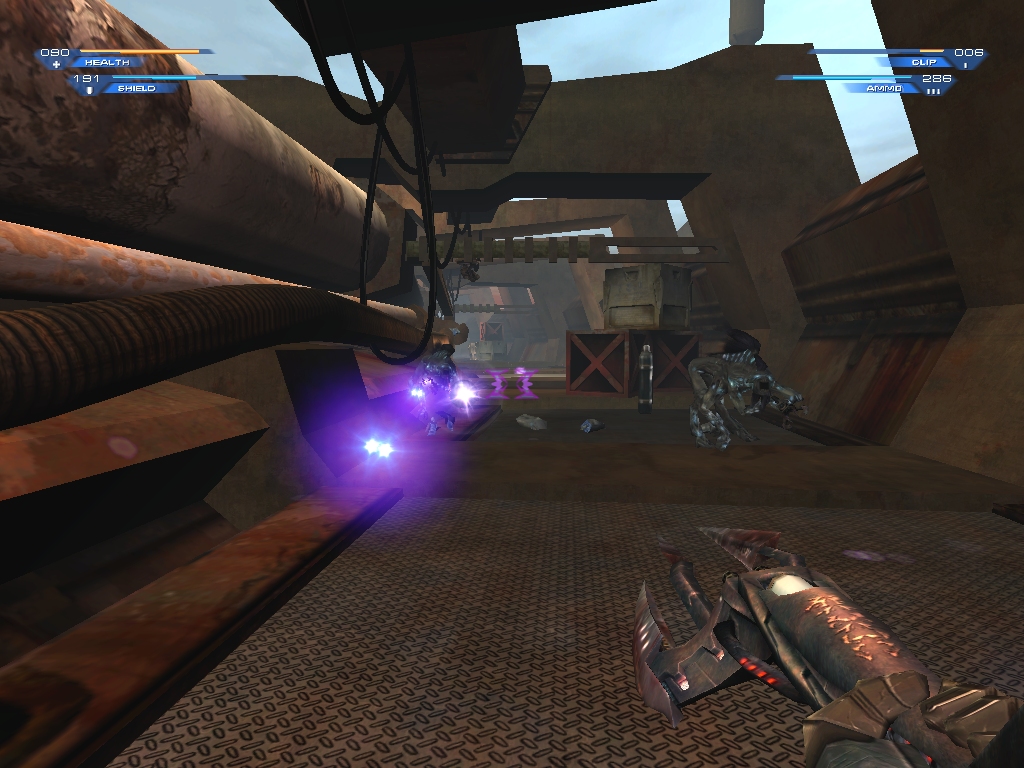
The creature roster in Unreal II is quite different. Although the Skaarj mark their return, there is no multiple variations, they rather come in light, medium and heavy classes. They received a few more moves to counter the player such as ability to deflect bullets with their blades. The Trooper class is absent this time, but their role is filled in by human opponents – mercenaries of Izanagi and Liandri corporations, who also happen to be split into three classes just like the Skaarj. There are also a slew of brand new alien species: with the most interesting being ape-like Izarians and biomechanical Drakk abominations encountered during the final mission of the game.
Enemies are sometimes fought in a kind of “tower defense” scenarios. These require you to set up defense around a given perimeter via deploying stationary weapons and ordering human allies around. Once preparations are complete, you have to hold your position until all enemy waves are wiped out. It goes without saying that these moments slow down pace of the game and don’t feel like Unreal at all. Just like conversations with NPCs which might also appear as annoyance to players expecting non-stop action and exploration just like in the original game.
Owing to capabilities of the second iteration of Unreal Engine, the levels are beautifully detailed and make extensive use of static brushes, as opposed to troublesome constructive solid geometry low-poly architecture. It also allowed to make levels even bigger and detailed by comparison, though most of the gameplay occur in relatively confined spaces. Of course, the editor is still here, updated to version 3.0, but Unreal II didn’t see any major mods or custom campaigns the first game had in spades.
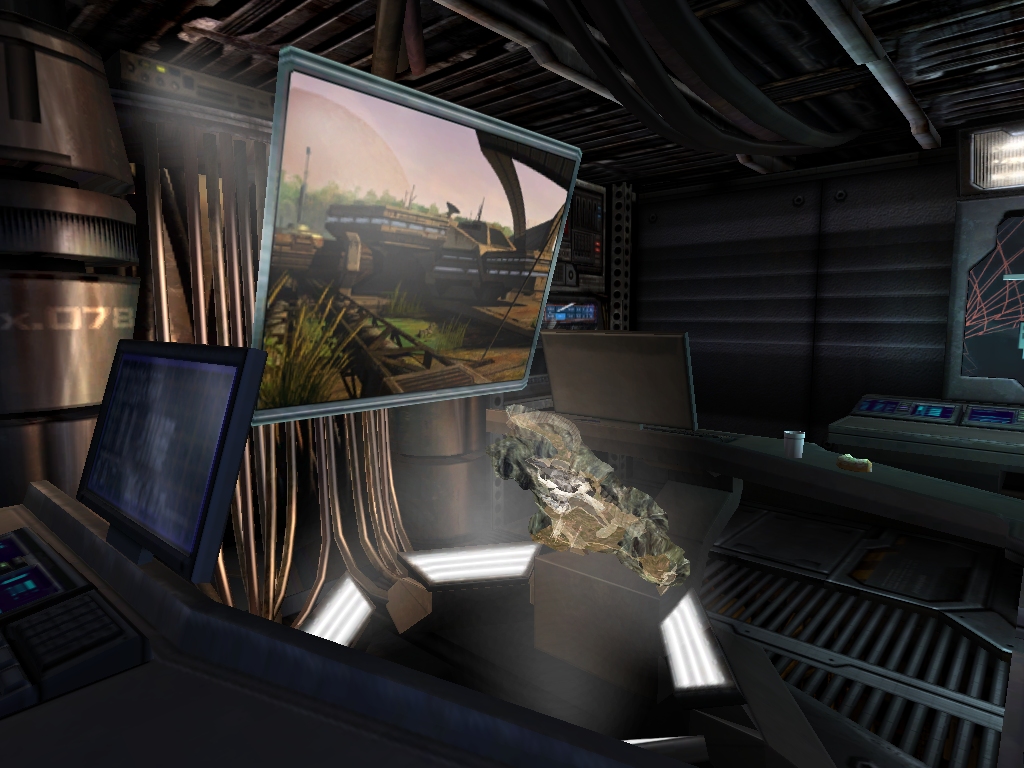
The sound work is not particularly bad or good either, but the soundtrack is certainly not as memorable as in the first game. Most songs were composed by Jack Wall and Jeremy Soule, but one track by Alexander Brandon was included and one can definitely notice its distinct style stands out from the rest. Additionally, the module format is completely ditched in favor of Ogg Vorbis files, which is understandable considering how hard disks grew in capacity, thus allowing better quality, but streamed audio doesn’t have all the tricks that module files posses.
Some time after its release, Unreal II featured expanded Multiplayer mode, which is a team based one, predating Onslaught mode from Unreal Tournament 2004 (albeit without vehicles). Legend clearly wanted to do away with the good old deathmatch, but to no avail, which is not a surprise, especially when they didn’t include the multiplayer component at the game’s release. Development of XMP was halted with the closure of Legend Entertainment and the upcoming release of Unreal Tournament 2003.
Unreal II isn’t a bad game on its own, it’s just a different one, and it’s not even trying to improve on its predecessors’ qualities, which is why many fans of the franchise look down on it. Most likely because of too numerous changes to the gameplay and setting, it’s more or less similar case to Deus Ex: Invisible War. But if you forget how little it resembles the original Unreal, you might really enjoy this game.
Trivia
German version
In the German version, all blood and gore effects were removed. Also some corpses in the levels were replaced or removed. The later released Special Edition is not affected.
John Dalton
The main character's last name, Dalton, was based on Scott Dalton, one of Unreal II's game designers. The developers tried to avoid the name collision for a while, but in the end "Dalton" just seemed to work best for the game and was used in the final product.
Multiplayer
A patch to this game adds multiplayer, vehicles and new weapons. It is called Expanded Multiplayer or Unreal II XMP.
References
Coincidence...or not? The player you control in the game, sometimes appreviated as "U2," is named John Dalton. In the late 80's, the Irish rock group U2 would sometimes dress up as a country western band and open for their own shows. The name of the group?: The Dalton Brothers.
An NPC in the tutorial area muses about getting himself two flags and conducting a some kind of tournament. An obvious reference to the Unreal Tournament series of games.
Seagoat
The Seagoat, the alien, bunny-like pet that shows up on the player's ship during mid-game, was created very early on in development and originally thought to be a huge, bovine creature that could inhabit one of the alien worlds in the game. During development, the name "Seagoat" started to stick for the creature, and it was greatly reduced in size and given the role of cute, slightly weird pet.
Voice acting
Even though all other voices for the game were performed by professional actors, Ne'Ban, the ship's alien pilot, is voiced by one of the developers (Grant Roberts).
